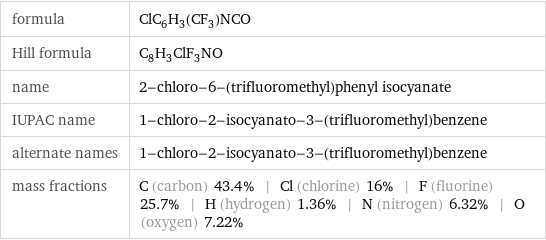Input interpretation

2-chloro-6-(trifluoromethyl)phenyl isocyanate | orbital hybridization
Result

First draw the structure diagram for 2-chloro-6-(trifluoromethyl)phenyl isocyanate, and for every non-hydrogen atom, count the σ-bonds. Note that double and triple bonds consist of one σ-bond together with one or two π-bonds: Identify those atoms with lone pairs: Find the steric number by adding the lone pair count to the number of σ-bonds: Consult the following chart to determine the hybridization from the steric number: steric number | hybridization 2 | sp 3 | sp^2 4 | sp^3 5 | dsp^3 6 | d^2sp^3 7 | d^3sp^3 Now assign the hybridization for each atom: Answer: | |
Chemical names and formulas

formula | ClC_6H_3(CF_3)NCO Hill formula | C_8H_3ClF_3NO name | 2-chloro-6-(trifluoromethyl)phenyl isocyanate IUPAC name | 1-chloro-2-isocyanato-3-(trifluoromethyl)benzene alternate names | 1-chloro-2-isocyanato-3-(trifluoromethyl)benzene mass fractions | C (carbon) 43.4% | Cl (chlorine) 16% | F (fluorine) 25.7% | H (hydrogen) 1.36% | N (nitrogen) 6.32% | O (oxygen) 7.22%